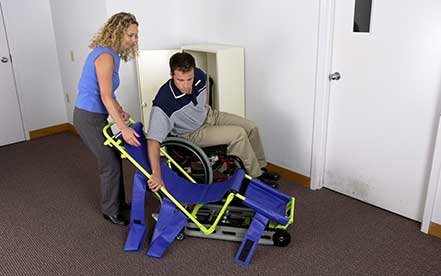Where Evacuation Chairs are headed in the next 5 years
Businesses in the United Kingdom are responsible for guaranteeing the safety of their employees while on the job. In the case of an emergency, every company owners should have an evacuation plan in place that covers all employees, including any handicapped employees.
7.5 million people the UK are disabled and part of the workforce, and many of them continue to encounter prejudice in the workplace. Many organizations lack a proper evacuation strategy or appropriate evacuation equipment, and male handicapped workers are considered to be paid 19 percent less than non-disabled male employees. With this in mind, it’s critical that any reputable company guarantees that handicapped employees have access to facilities that allow them to securely exit the facility.
How evacuation chairs are benefiting people
A “mobility challenged” individual isn’t simply someone who is physically crippled; it may also be someone who has back injuries, asthma, or any other form of cardiac issue that limits their mobility. An evacuation chair allows for improved movement and is ideal for evacuating a handicapped employee down many flights of stairs in tight locations.
Evacuation chairs and associated gadgets are meant to make it easier for those with mobility issues to evacuate safely and quickly. A wide range of products are available, varying in size, style, and function, but they usually take the form of a lightweight, compact, but sturdy wheeled chair with straps to ensure the passenger’s safety and stability, handles, and grips to make the chair easily maneuverable by a designated operator, and some type of sliding mechanism to allow the chair to be moved quickly and safely down a flight of stairs.
Whether your place of business is a retail or commercial location, a school or college, a hotel, a hospital, or a care facility, a variety of laws and industry regulations will dictate your responsibilities for the safety of the people on your premises, both on a day-to-day basis and in an emergency. Legislation – and common sense – imposes a unique responsibility of care on individuals who are particularly vulnerable, such as persons with impairments, injuries, or other mobility limitations.
During an evacuation, what are your responsibilities?
There are a variety of reasons why a building may need to be immediately evacuated. Although fire evacuations are the most prevalent, other reasons for evacuation might include anything from a potentially harmful spill or leak to the fear of a terrorist attack. Regardless of the nature of the event, you have a responsibility to ensure that the premises are vacated quickly and safely – and if you have employees, customers, or patients who use wheelchairs or have other special mobility needs, this responsibility includes ensuring that those who are at risk are able to evacuate the premises quickly and efficiently with the help of designated staff and, where appropriate, dedicated equipment.
Choosing a chair for evacuation
Most evacuation chairs fold up for simple storage on the premises, and the finest ones combine convenience of usage with passenger comfort. Hydraulic brake devices for better control on stairs are common in more complex evacuation goods, and some contain a fully powered drive unit that permits controlled travel both down and up steps (for example if evacuating from basement premises).
In the case of an evacuation, an evacuation chair is a critical piece of equipment for many organizations to protect the safety of employees, customers, or patients with unique mobility requirements. Our evacuation chair training is perfect for anybody who wants to get the most out of their product and guarantee that their employees are comfortable and confident while using it.
It’s important to provide emergency help for those with limited mobility since they’re more likely to be injured or die. Disabled and bedridden persons, for example, account for 8% of all fire-related fatalities and 2% of all fire-related injuries in Canada, while those over the age of 65 account for 18% of all fire-related deaths and 7% of all fire-related injuries.
Of course, having safety gear in place for those with impaired mobility satisfies emergency evacuation rules as well. Section 125 of the Canada Labour Code, for example, states:
“Every employer should, to the extent that the employer controls the activity, in respect of every work place controlled by the employer and in respect of every work activity carried out by an employee at a work place that is not controlled by the employer.”
Although the legislation does not require companies to have evacuation plans on hand, it does state that they must do everything possible to establish a safe evacuation path in the event of an emergency.
Directaccessgp mentioned that you have to remember that persons who use crutches in your building may find it difficult to move about with folks swarming around them. Those with less evident health issues, such as breathing or heart difficulties, may have difficulty descending the stairs alone during an evacuation. People in wheelchairs, on the other hand, are unable to utilize the stairs.
Other useful characteristics of evacuation chairs
Other characteristics of our necessary accessibility equipment that may be useful in a catastrophe include:
- Only one person is needed to properly evacuate the evacuee using the Evacuation chair.
- It’s light enough for anybody aiding someone with limited mobility to carry.
- Despite its modest weight, it is sturdy enough to securely carry a person weighing up to 180 kg down the stairs, and it may be used by a light person to assist an evacuee who is heavier.
- The Evacuation chair folds up into a small package and can be conveniently stored using the wall-bracket system in a suitable and accessible position.
- It features rubber tracks to slow down the evacuee’s fall and won’t drive them ahead.
- Because of its solid structure and outstanding design, the Evacuation chair may also be used as a transport chair.
Final words
The last thing you want is for those with limited mobility to take a chance on utilizing an elevator in an emergency. An elevator may lose electricity during a crisis and become a death trap. When a building is in danger, rescue teams sometimes find it more difficult to help persons stuck in elevators.











